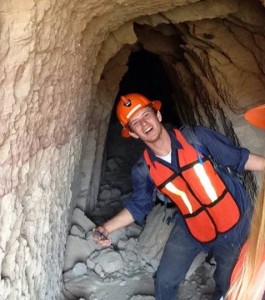Geochemical Analysis of Arc to Rift Transitional Volcanism of the Boleo Copper District: Santa Rosalia, Baja
Jonathan Rice
BS Candidate
Advisor: Dr. Dave Kimbrough
Thursday, May 5th, 2016
CSL 422 – 10:30am
watch Jonathan’s defense
Abstract
This study examines major and trace element volcanic geochemistry of the subduction to rift transition in volcanic rocks of the Santa Rosalia basin, adjacent to the Gulf of California (Mexico), as part of the Baja Basins NSF REU (National Science Foundation-Research Experience for Undergraduates) project.
Based on K/Ar geochronology and geochemical work by Conly (2005), this transition is recorded in volcanic rocks less than ca. 12 Ma in the Santa Rosalia basin, thus raising the possibility that rift volcanism played a role in the generation of the ca. <7 Ma Boleo-type stratabound Cu-Mn-Co deposits that are being actively mined from sedimentary rocks of the basin.
Our sample compositions include basalt, basaltic trachyandesite, basaltic andesite, andesite, trachyandesite, dacite, and rhyolite from lavas, lava domes, intrusions, block-and-ash flow tuffs, ignimbrites, and pyroclastic fall deposits. Although all samples show calc-alkaline trends consistent with subduction regimes, three groups emerge based on trace element plots and Eu anomalies in normalized rare earth element diagrams. These indicate multiple magmatic sources and variable degrees of partial melting indicated by La/Sm vs La plot, and presence of adakite-like signatures in Sr/Y vs Y plot. This is consistent with partial melting of very young, relatively hot, oceanic crust rather than basic dehydration processes associated with normal subduction.


